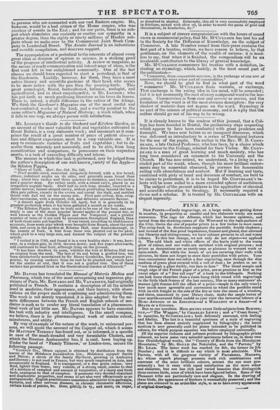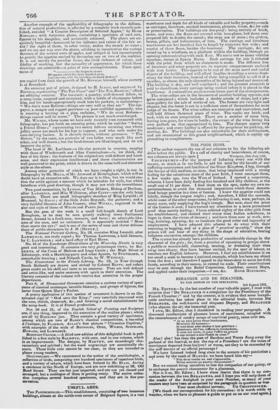FINE ARTS.
NEW Prix/qrs.—Costly engravings, on a large scale, are getting fewer in number, in proportion as smaller and less elaborate works are more numerous. The rage for Albums, which has become epidemic, and spread from the drawing-rooms of the West-end to the back-parlours of the City, limits the size of popular prints to a few inches in most cases. The scrap-book in duodecimo supplants the portfolio double elephant ; and instead of the fine proof impressions, framed and glazed, that adorned our libraries and sitting-rooms, we have cabinet pictures in oil and water colours. To this last change, we not only do not object—we applaud it. The cold black and white effects of the burin yield to the warm glow of colour, and our walls are enriched with original pictures ; and prints as decorations are as rarely seen as pictures in worsted work or satin-stitch. But while the lovers of art are covering their walls with pictures, let them not forget to store their portfolios with prints. Your true connoisseur does not relish a fine engraving, seen through the dim medium of green glass covered with a veil of dust ; he prefers to see it "not through a glass darkly, but face to face." The broad margin and rough edge of the French paper of a print, are as precious to him as the uncut edges of a" fine tall copy" of a book to the bibliopole. Nothing can look more cheerless thane room hung thick round with engravings in the little black frames of the last century, like so many stationers' al. manacs (gilt frames kill the effect of a print—maple is the only wear): how much more agreeable and convenient to wheel the portfolio stand with its rich freight to the side of the lire or into the recess of a window, and there, ensconced in your library chair, make the ample leaves of your marble-covered folios unfold to your view the immortal labours of a MARC ANTONIO or an EDELINCE—..Of a WOOLLETT or a Suaitr—of a HEATH or a COUSINS.
But to our novelties. Here are two sweet little subjects from BONING.. Torr,—" The Waggon," by CHARLES LEWIS ; and a" Coast Scene," in aquatint, by SUTHERLAND; both delicately executed, with feeling and fidelity. The last is a beautiful specimen of a style of engraving that has been almost entirely supplanted by lithography ; the latter medium is now generally used for plates intended to be published in colours, for which purpose aquatint was before employed universally. Of the superior richness and softness produced by lithographic prints coloured, we have some very splendid specimens before us, in those two fine Ornithological works, the " Century of Birds from the Himalayan Mountains," by Mr. GoULD the Naturalist, and the " Parrots," by Mr. LEAR. The latter work has reached its 6th, the former its 7th Number ; and it is difficult to say which is most admirable. The Parrots, with all the gorgeous variety of Parrakeets, Maccaws, &c. whose superb plumage presents such rich combinations and contrasts of the most brilliant colours, attract the eye most pro- minently ; but it rests with equal satisfaction on the more sober and elaborate, but not less rich and varied beauties that distinguish these curious birds, none of which have been figured before. Some of the Pheasant tribe are particularly rare and elegant. In the drawing of these birds, the appearance of feathers is successfully preserved ; and the plates are coloured in an artist-like style, so as to have every appearance of original drawings. Another example of the applicability of lithography to the delinea- tion of natural productions, is affurded by a complete work recently pub- lished, entitled "A Concise Description of Selected Apples," by neon RONALDS ; with forty-two plates, containing a specimen of each sort, figured by his daughter, and accurately coloured. The plates are ex- quisitely beautiful—honoured be the industry and talent of the fair ar- tist ! the sight of them, in sober verity, makes the mouth to water ; and we ate our way over the plates, relishing in imagination the various flavours of the several sorts of apples, and obliged at last incontinently to gratify the appetite excited by devouring one or two of the realities. It is not merely the peculiar forms, the vivid richness of colour, and fidelity of marking, but the rotundity of appearance, for -which these drawings are admirable—a point of rare accomplishment. These speci. nuns of r, the fragrant stores Of apples which the lusty handed-year,
Innumerous, o'er the binshisig orchard shakes,"
are copied from fruit the growth of Mr. RONALDS himself, whose nursery is at Breutford.
An amusing pair of prints, designed by H. ALKEN, and engraved by ZEITTER, representing " The Tax-Payer" and " The Tax-Receiver," afford an edifying contrast. The tax-eater, a punchy, well-dressed fellow, in a snug room, carpeted and curtained, with a bottle of champagne before Lim, and his hands appropriately stuck into his pockets, is exclaiming- " We don't want Reform—things are very well as they are." The tax- payer, a meagre and ragged garreteer—a poor scribbler apparently, who is roasting a herring on a pipe, exclaims, " We do want Reform— things cannot well be worse." The picture is not much overcharged.
Mr. Witatar, whose name we have only recently seen connected with lithography, has put forth an amusing print, which he entitles " Seeing a Friend Home ;" representing two merry fellows escorting one whose jollity seems too much for his legs to support, and who reels under his care-defying burden. It is cleverly drawn, without grossness. " The Sisters," by the same, are portraits of two ladies very much like each other, and well drawn ; but the head-dresses are ill-arranged, and do not improve the print.
The head of Mr. Lockhart—a life-size portrait in crayons, ranging with those of Wordsworth and Allan Cunningham—is, we think, the Lest of the three : the features of the original are well-defined and hand- some, and their expression intellectual ; and these characteristics are well preserved in the print, which is drawn in the same bold and elaborate style as the others.
Among other portraits of which we have caught a sight, is one in lithography by Mr. MILLS, of Mr. Attwood of Birmingham, which will no doubt have an extensive sale. We dare say it is like, but we would cau- tion the artist against a manner which he mistakes for style, but which interferes with good drawing, though it may not with the resemblance.
Two good mezzotints, by Lerma, of Van 'Widen, Bishop of Durham, after LAWRENCE, and Miss Wilkinson, after CLINT—are the only large portraits. There are small lithographic sketches of King Leopold ; of Hummel, by OAECI ; of the little Jules Regondi, the guitarist; and a very faithful likeness of John Cramer, after WIVELL, engraved in the size and style of those of Wer.sit and PARRY jun.
But the gem of the week is a small full-length sketch of Lord Brougham, as he may be seen quietly walking down Parliament Street, dressed in a frock-coat, trousers, and boots ; an admirable like- ness of the man, and no caricature. It is appositely entitled " More than meets the eye;" and is one of the series of neat and clever delinea- tions of public characters by J. D. (Doyax.)
The National Portrait Gallery, No. 28, contains King Leopold, after LAWRENCE, not truly copied ; Sir Thomas Lawrence, a bald likeness, by C. LANDSEER ; and a hard effigy of Earl Howe.
No. 16 of the Landscape Illustrations of the Wavcrley Novels is very good and interesting. It contains two very picturesque views, by Ro- BEATS, of the Cross of Melrose and Lagg Castle ; the High Street of Edinburgh, with a Hawking-party and other figures, by STOTRARD, a remarkable drawing ; and Nidpath Castle, by W. WESTALt.
The Illustrations to the Family Library, No. 23, (a Tour through South Holland) are drawn and etched by Colonel BATTY, and reflect great credit on his skill and taste as an amateur. They are well defined and artist-like, and unite neatness with spirit in their execution. The literary contents of the volume will receive due attention in the proper department.
Part 6, of Illuminated Ornaments contains a curious variety of speci- mens of classical arabesque, heraldic blazonry, and groups of figures, the latter from Queen Mary's Psalter. A pretty application of this species of ornament is shown in an illu- minated copy of " God save the King ;" very tastefully decorated with the rose, thistle, shamrock, &c. and forming a novel embellishment for the scrap-book. It is of French production:
Nos. 20 and 21, of the English School of Painting and Sculpture are, if any thing, improved in the execution of the outline plates; which are all by NORMAND jun. They contain a good variety of specimens, among which are two of BARRY'S classiCal compositions, a has-relief d l'antigue, by PLAXMAN, ALLAN'S fine picture " Circassian•Captives," with examples of the style of REYNOLDS, OPIE, WILKIE, STOTHARD, HOWARD, and LAWRENCE.
ROBINSON CRIJSOE.—A third'new edition of this delightful book is pub- lished in a fine style by BALDWIN, with cuts, and in one volume, which is an improvement. The designs, by HARVEY, are exceedingly cha- racteristic and spirited ; but the wood engravings are occasionally ob- scure. These little cuts cannot be too clear, as they are intended to please young readers. ORNITROLOGY.—We recommend to the notice of the ornithologist, a collection of birds, comprising two hundred specimens of rapacious birds, and a variety of others, which have been formed by Mr. ELLIS, during a residence inthe North of Europe, and are now exhibiting at 28; Old. Bond Street. They are but just imported; and are not yet classed and arranged; but a catalogue of them is getting ready. The entire collec- tion comprises several hwadred specimens, and they are in fine pre-



























 Previous page
Previous page